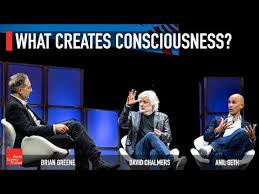What Creates Consciousness?
Renowned researchers David Chalmers and Anil Seth join Brian Greene to explore how far science and philosophy have gone toward explaining the greatest of all mysteries, consciousness–and whether artificially intelligent systems may one day possess it.
David Chalmers is a prominent philosopher known for his work in philosophy of mind and consciousness studies. He coined the term “hard problem of consciousness,” which refers to the challenge of explaining why and how subjective experiences arise from physical brain processes. Chalmers is also a professor at New York University and the Australian National University, contributing extensively to debates on the nature of reality, artificial intelligence, and the philosophy of cognitive science.
00:00 – Introduction
02:35 – Participant Introductions
03:50 – Will an Artificial System Ever Become Conscious?
05:32 – The Hard Problem of Consciousness
08:32 – Thought Experiment: Mary and the Nature of Conscious Experience
13:28 – The Hard Problem and The Real Problem of Consciousness
21:53 – The Brain as a Prediction Machine
25:41 – Possible Solutions to the Hard Problem
33:15 – Will AI Systems Become Conscious and How Will We Know?
40:11 – Is Human Consciousness the Only One Example of Conscious-like Experience?
42:19 – The Future of Creating Consciousness and the Ethical Questions
Anil Seth is a cognitive neuroscientist and professor at the University of Sussex, specializing in consciousness and perception. He is known for his work on predictive processing, suggesting that the brain constructs reality as a “controlled hallucination” based on prior beliefs and sensory inputs. Seth’s research spans neuroscience, artificial intelligence, and philosophy, and he is also an engaging science communicator, notably the author of Being You: A New Science of Consciousness.
Essential Ideas
Chalmers
David Chalmers’s essential idea about consciousness revolves around its fundamentally mysterious and non-reducible nature, encapsulated in his distinction between the “hard problem” and the “easy problems” of consciousness:
Key aspects
- The Hard Problem: This is the question of why and how physical processes in the brain give rise to subjective experiences (qualia), such as the redness of red or the taste of chocolate. Chalmers argues that explaining these first-person experiences cannot be fully achieved through the standard physicalist explanations of brain activity because they address only objective, observable phenomena, not the subjective, inner world of experience.
- The Easy Problems: These involve explaining cognitive functions and behaviors, such as information processing, memory, attention, and decision-making. These can, in principle, be addressed by neuroscience and psychology because they focus on mechanisms and functions.
Chalmers proposes that consciousness might be a fundamental property of the universe, similar to space, time, or mass. He suggests exploring frameworks like panpsychism, the idea that consciousness could be a fundamental feature of matter, or considering that it might require new, yet undiscovered, principles of physics to fully understand it. His perspective challenges strictly reductionist views and invites a broader, interdisciplinary approach to studying consciousness.
Anil Seth
Anil Seth’s essential idea about consciousness centers on the notion that it arises from the brain’s predictive processes, emphasizing a scientific and empirically grounded framework. He views consciousness as a controlled hallucination where the brain actively generates models of the world and the self, refining them based on sensory inputs.
Key Aspects
- Predictive Processing: Seth argues that the brain doesn’t passively receive information from the world; instead, it predicts the causes of sensory signals using prior knowledge. Sensory inputs then serve to update or correct these predictions, creating our perception of reality.
- Perception as a Hallucination: He suggests that perception is akin to a “hallucination controlled by the external world.” When predictions align well with sensory data, we experience a stable sense of reality. When they don’t, errors occur, leading to phenomena like optical illusions or altered states of perception.
- Self and the Body: Seth emphasizes that our sense of self is deeply rooted in bodily processes. For example, interoception (the brain’s perception of internal bodily states) plays a crucial role in shaping the subjective experience of being “you.”
- Consciousness as Multi-Dimensional: Rather than seeing consciousness as a single phenomenon, Seth breaks it into multiple dimensions, including the level of arousal (awake vs. asleep) and the content of experience (what we are aware of).
Anil Seth’s approach is grounded in neuroscience and cognitive science. It offers a framework that connects subjective experience with measurable brain processes. This makes consciousness more approachable for scientific investigation while emphasizing its deeply personal, constructed nature.

